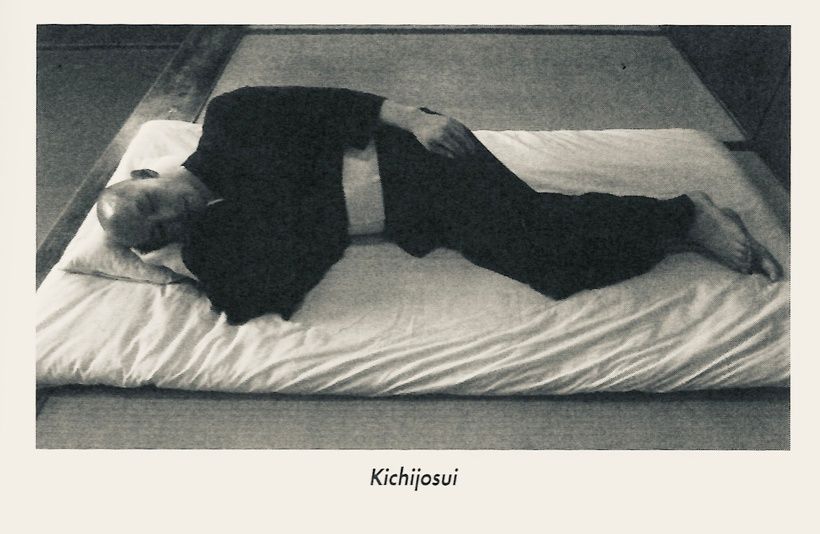The Zen Way of Sleep

Recently, Meido Moore Roshi posted a short fireside sesshin talk about sleep practice. You can find it here. In the talk, Meido Roshi mentions the Soto monastic practice for sleep that I have shared bits and pieces of before, so I thought I might stitch it together for you.
One aspect is the Sovereign Lion's Pose (kichijosui). See the above photo. Although it has been stressed in Soto monasteries at least since the time of Keizan Zenji (1261-1325) and his Keizan Shingi, it isn't just for monastics or sesshin participants. I've been practicing this nightly for forty-some years and recommend it to students whatever their lifestyle might be.
Shakyamuni Buddha entered nirvana in this pose, as is well-known, and the Pali Canon contains many instances of the living Buddha assuming this posture, sometimes lying down during a talk to give his aging back a break, turning the teaching over to Shariputra or Maudgalyayana. The Sovereign Lion is also recommended elsewhere in the buddhadharma literature, for example, in the Sutra of Three Thousand Manners and Dogen's Bendoho.
Here are the basics of how Katagiri Roshi taught me to practice sleep:
Before lying down, sit on the futon/bed with hands in gassho, and set your intention for sleep by reciting this gatha (silently to oneself is fine):
Going to sleep tonight
Vowing with all beings
To calm all things,
Leaving the mind pure and clear
Next, lie down on the right side in the Sovereign of Lion's Pose. Carefully note the details in the above photo for the hands, legs, and feet. Then continue the practice your practice - zuisokkan (breath) or keyword - as you drift into sleep.
Doing so allows for the practice to continue during sleep, including in lucid dreaming. I often find myself sitting zazen in my dreams, especially when in sesshin or retreat. Once I dreamt that I was sitting and facing the wall in a big circular zendo made of jade. I was surprised that I was in the row of senior monks. Katagiri Roshi passed behind the row of practitioners, walking so slowly, one step per breath as in kinhin.
The sleep gatha and the pose help bring our practice into the sleep process - going to sleep, sleeping, and waking up. I find the liminal zones before and after deep sleep especially powerful for koan work and so was struck that Meido Roshi also experienced this (as he mentions in the above linked talk). While I was working through the Harada-Yasutani koan curriculum, many koans opened during sleep.
If we wake up in the night and find the body in some other position simply move back to the right side. When it's time to get up, again sit on the futon/bed with hands in gassho, and set our intention for the day by reciting the gatha for waking up:
Waking up in perfect peace
Vowing with all beings
To realize everything without exception
Embracing the ten directions
There are many virtues of sleeping on one's right side, primarily, it allows the muscles, spine, and organs all to relax and release. Also the heart isn't pressed by other body parts, and so energy can flow freely through the body. We've found that this pose reduces snoring by about 80% - no small thing when sleeping with others (like in the dorm room for a Vine sesshin or at Korinji!).
In Japanese Soto monks' halls, traditionally, the monks sleep tan-to-tan and because the tans are less than three feet wide, each monk will have a monk right next to them. Sleeping in this way creates the container for harmonious community sleeping practice. By the way, the futon that I've seen and used in monks' halls are a LOT thinner than the one pictured above by a factor of about eight.
It is possible and important to continue our practice during sleep and also to be thoroughly refreshed in the radiant light of absorption (aka, samadhi) from sleep. Narasaki Tsugen Roshi, a wonderfully kind Soto master of the Zuioji senmon sodo who recently died, says in his Practices at a Zen Monastery (also the source of the above photo),
"Practitioners should be mindful of the light of all the Buddhas and the heavenly guardians while they are sleeping. This protects one's mind and posture from falling into laziness while sleeping."
The light of the Buddhas and heavenly guardians is, of course, the light of samadhi as states of absorption are associated with god realms.
And, yes, that's Zen alright - don't you be doing lazy sleep!
Finally, if you experience issues with falling asleep or waking in the wee hours due to life stresses or just the normal broken-sleep pattern that many of us older people undergo, you might try maintaining the Sovereign Lion and repeatedly reciting Enmei Jukku Kannon Gyo (Ten Line Life Prolonging Kannon Sutra), Shosai Myokichijo Darani (Marvelously Beneficial Disaster Preventing Dharani), or the Three Refuges. Find the rhythm in the recitation such that the verse falls into a body-based form of "playback mode" (aka, earworm). Then even if you don't fall asleep soon (which you may), you might still have a powerful session of practice.
Comments and questions are welcome.